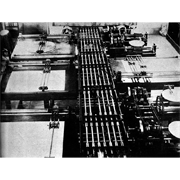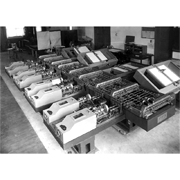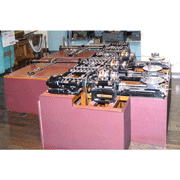Published on Nov. 16, 2012
Last updated on Mar. 7, 2024
Sasaki Tatudirou and others at Kagaku Dai-2bu of Tokyo Imperial University’s Aeronautical Research Institute, in 1942, prototyped the country’s first differential analyzer, as a joint research project with Showa Koukuu-Keiki Kennkyu-bu.
The machine called as “differential analyzer” is a large mechanical analog computer used to solve ordinary differential equations with integrators and other components. James Thomson first described the principle by which a differential equation could be solved by combining integrators in 1876, and Vannevar Bush at MIT placed the first practical machine in 1931. The machine, dubbed “Differential Analyzer”, was capable of solving sixth-order differential equations. Its design architecture soon spread around the world, and the word “differential analyzer” became commonly used.
The Aeronautical Research Institute’s differential analyzer consisted of four integrators, one multiplier, two input consoles, and one output console and was capable of solving fourth-order differential equations. Later, work on the practical machine that would solve eighth-order differential equations began, but it was destroyed in the war just prior to completion. The 1942 prototype machine was kept at Institute of Science and Technology, the successor to the Aeronautical Research Institute, and the University of Tokyo’s Institute of Industrial Science, established in 1949, took a leading part in doing research on a differential analyzer, also maintained and improved the prototype.
Watanabe Masaru, Miida Junichi, and others at the Institute of Industrial Science, from their experience with the prototype, proceeded to develop a new differential analyzer that was larger, more accurate, and easier to handle. This machine, when completed, comprised eight integrators, nine adders, three input consoles, one output console, and a coupling device. Attached to the main machine were independent variable distribution panels and other units. Work on the machine began in 1951 and was completed in 1955. It was primarily built at Tokyo Keisokuki Seisakusho, but some components were constructed at the Institute of Industrial Science’s factory for trial manufacture. The actual accuracy was reported to be a 0.12 percent margin of error on circle tests, with each independent integrator having a 0.03 percent margin of error. These were the highest accuracy levels in the world at the time.
Inputs in the prototype had to be tracked manually from the input console following the curve of the equation to be analyzed. To boost the input accuracy and speed, the team developed an automatic tracking device that automatically traced the curve. It was realized by contriving photoelectric heads. The introduction of the automatic tracking device raised the tracking accuracy and speed by a factor of almost 10 over manual methods, adding significantly to the analyzer’s overall precision.
A mechanical torque amplifier was used for increasing the power of an integrator’s output and transmitting it to the coupling device from a practical point of view, because mechanical amplifiers worked reliably and because electric amplifiers were only at the research stage in Japan at the time.
The Institute of Industrial Science started developing rockets in 1955, when the differential analyzer was completed. The differential analyzer’s eight integrators were used to their fullest extent to calculate the trajectories of the Baby rockets and Kappa rockets.
MathSci Experience Center, TUS* now holds a machine that is consisted of three integrators, one input console, one output console; that is very similar in construction to the Aeronautical Research Institute’s original differential analyzer. Because it bears the nameplate of Showa Kookuu-Keiki, the machine is thought to have been built by Showa Kookuu-Keiki at almost the same time as the Aeronautical Research Institute’s machine. Shimizu Tatsujiro at Osaka University’s Department of Science reportedly possessed and used a differential analyzer in 1947, and because he later moved to the Tokyo University of Science via Kobe University and Osaka Prefecture University, the differential analyzer at Osaka University likely followed him to the Tokyo University of Science. The machine was refurbished at Museum of Science, TUS over a period of about 18 months and was put back into working order and displayed in December 2014.
(*Tokyo University of Science)




